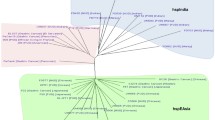Abstract
From the literature review, there seem to be no studies conducted on infection caused by Helicobacter pylori in patients with gastric MALT lymphoma in the KSA region. The present research is an attempt to understand the prevalence of patients infected with H. pylori in the selected region and the role of allelic imbalance of chromosome 3p regions to understand the clinical manifestations and features associated with MALT lymphomagenesis. The researcher analyzed the frequency of infection in patients from the region of Saudi Arabia by examining the data collected from hospitals and biopsy tissue samples as per the recommended protocol. The endoscopic diagnosis was performed to collect biopsy samples. Histology and AP-PCR DNA fingerprinting analyses were performed from the endoscopic gastric mucosal biopsies collected from patients with associated gastric MALT lymphoma. The existence of H. pylori was examined based on the results of gastric mucosal biopsies stained with hematoxylin–eosin (H&E) and Steiner’s silver stains. MALT, MALT lymphoma tissue samples and H. pylori-positive chronic gastritis were examined for LOH at chromosome 3p24 using standard procedures and techniques. The findings of the paper revealed the H. pylori was found to be positive in 17% of the cases significantly high among the age group of 31–50 years. Patients with MALT, MALT lymphoma, and H. pylori-associated gastritis presented features such as lymphocyte accumulation, vacuolation, Peyer’s patch appearance, and lymphatic follicles. H. pylori were found to appear as a dense colored accumulated mass in the gastric epithelial layer. The findings from AP-PCR generated DNA fingerprints revealed intense band including two prominent bands in MALT lymphoma. Among other loci, 3p24 was the only one locus that showed high percentages of LOH as reported earlier in all cancer-related cases. The findings of this research paper empower the fact that allelic imbalances play a vital role in the development of MALT lymphoma. However, future researches should be conducted to identify the chromosome regions of the AP-PCR generated DNA fingerprints of human gastric MALT lymphoma in order to confirm this proposition.



Similar content being viewed by others
References
Lee AD, Fox J, Hazell S (1993) Pathogenicity of Helicobacter pylori: a perspective. Infect Immun 61(5):1601
Mobley HL (1997) Helicobacter pylori factors associated with disease development. Gastroenterology 113(6):S21–28
Uemura N, Okamoto S, Yamamoto S, Matsumura N, Yamaguchi S, Yamakido M, Taniyama K, Sasaki N, Schlemper RJ (2001) Helicobacter pylori infection and the development of gastric cancer. N Engl J Med 345(11):784–789
Makola D, Peura DA, Crowe SE (2007) Helicobacter pylori infection and related gastrointestinal diseases. J Clin Gastroenterol 41(6):548–558
Chan AO, Chu KM, Yuen ST, Leung SY, Lam SK, Wong J (2001) Synchronous gastric adenocarcinoma and mucosa-associated lymphoid tissue lymphoma in association with Helicobacter pylori infection: comparing reported cases between the East and West. Am J Gastroenterol 96(6):1922–1924
Lindkvist P, Asrat D, Nilsson I, Tsega E, Olsson GL, Wretlind B, Giesecke J (1996) Age at acquisition of Helicobacter pylori infection: comparison of a high and a low prevalence country. Scand J Infect Dis 28(2):181–184
Bardhan PK (1997) Epidemiological features of Helicobacter pylori infection in developing countries. Clin Infect Dis 25(5):973–978
Allum WH (2013) Epidemiology, genetics and screening for oesophageal and gastric cancer. In: MichaelGriffin S, Lamb P (eds) Oesophagogastric Surgery E-Book: Companion to Specialist Surgical Practice. Elsevier, Amsterdam, p 22
Chomvarin C, Namwat W, Chaicumpar K, Mairiang P, Sangchan A, Sripa B, Tor-Udom S, Vilaichone RK (2008) Prevalence of Helicobacter pylori vacA, cagA, cagE, iceA and babA2 genotypes in Thai dyspeptic patients. Int J Infect Dis 12(1):30–36
Sagaert X, Van Cutsem E, De Hertogh G, Geboes K, Tousseyn T (2010) Gastric MALT lymphoma: a model of chronic inflammation-induced tumor development. Nat Rev Gastroenterol Hepatol 7:336–346
Kim DY, Kim YS, Huh HJ, Choi JS, Yeo JS, Kwak BS, Chae SL (2011) A case of monoclonal gammopathy in extranodal marginal zone B-cell lymphoma of the small intestine. Korean J Lab Med 31:18–21
Kusters JG, van Vliet AH, Kuipers EJ (2006) Pathogenesis of Helicobacter pylori infection. Clin Microbiol Rev 19(3):449–490
Isaacson PG, Du MQ (2004) MALT lymphoma: from morphology to molecules. Nat Rev Cancer 4(8):644
Cavalli F, Isaacson PG, Gascoyne RD, Zucca E (2001) MALT lymphomas. ASH Educ Program Book 2001(1):241–258
Gossage L, Eisen T, Maher ER (2015) VHL, the story of a tumour suppressor gene. Nat Rev Cancer 15(1):55
Lasko D, Cavenee W, Nordenskjöld M (1991) Loss of constitutional heterozygosity in human cancer. Annu Rev Genet 25(1):281–314
Banerji S, Cibulskis K, Rangel-Escareno C, Brown KK, Carter SL, Frederick AM, Lawrence MS, Sivachenko AY, Sougnez C, Zou L, Cortes ML (2012) Sequence analysis of mutations and translocations across breast cancer subtypes. Nature 486(7403):405
Dixon MF (1994) Pathophysiology of Helicobacter pylori infection. Scand J Gastroenterol 29(suppl 201):7–10
Padilla PI, Wada A, Yahiro K, Kimura M, Niidome T, Aoyagi H, Kumatori A, Anami M, Hayashi T, Fujisawa JI, Saito H (2000) Morphologic differentiation of HL-60 Cells is associated with appearance of RPTPβ and induction of Helicobacter pylori VacA sensitivity. J Biol Chem 275(20):15200–15206
Sagaert X, De Wolf-Peeters C, Noels H, Baens M (2007) The pathogenesis of MALT lymphomas: where do we stand? Leukemia 21(3):389
Salim EI, Moore MA, Al-Lawati JA, Al-Sayyad J, Bazawir A, Bener A, Corbex M, El-Saghir N, Habib OS, Maziak W, Mokhtar HC (2009) Cancer epidemiology and control in the arab world-past, present and future. Asian Pac J Cancer Prev 10(1):3–16
Gatta L, Vakil N, Vaira D, Scarpignato C (2013) Global eradication rates for Helicobacter pylori infection: systematic review and meta-analysis of sequential therapy. BMJ 7(347):f4587
Lengauer C, Kinzler KW, Vogelstein B (1998) Genetic instabilities in human cancers. Nature 396(6712):643
Lord CJ, Ashworth A (2012) The DNA damage response and cancer therapy. Nature 481(7381):287
Rajagopalan H, Nowak MA, Vogelstein B, Lengauer C (2003) The significance of unstable chromosomes in colorectal cancer. Nat Rev Cancer 3(9):695
Klein CA, Schmidt-Kittler O, Schardt JA, Pantel K, Speicher MR, Riethmüller G (1999) Comparative genomic hybridization, loss of heterozygosity, and DNA sequence analysis of single cells. Proc Natl Acad Sci 96(8):4494–4499
Charames GS, Bapat B (2003) Genomic instability and cancer. Curr Mol Med 3(7):589–596
Goode EL, Ulrich CM, Potter JD (2002) Polymorphisms in DNA repair genes and associations with cancer risk. Cancer Epidemiol Prev Biomark 11(12):1513–1530
Deng G, Lu Y, Zlotnikov G, Thor AD, Smith HS (1996) Loss of heterozygosity in normal tissue adjacent to breast carcinomas. Science 274(5295):2057–2059
Sagaert X. Helicobacter pylori Infection and MALT Lymphoma. In Helicobacter pylori Research 2016 (pp. 423-441). Springer, Tokyo
Wotherspoon AC, Finn TM, Isaacson PG (1995) Trisomy 3 in low-grade B-cell lymphomas of mucosa-associated lymphoid tissue. Blood 85(8):2000–2004
Ott G, Kalla J, Steinhoff A, Rosenwald A, Katzenberger T, Roblick U, Ott MM, Müller-Hermelink HK (1998) Trisomy 3 is not a common feature in malignant lymphomas of mucosa-associated lymphoid tissue type. Am J Pathol 153(3):689–694
Oberstraß JÜ, Reifenberger G, Reifenberger J, Wechsler W, Collins VP (1996) Mutation of the Von Hippel-Lindau tumour suppressor gene in capillary haemangioblastomas of the central nervous system. J Pathol 179(2):151–156
Du M, Peng H, Singh N, Isaacson PG, Pan L (1995) The accumulation of p53 abnormalities is associated with progression of mucosa-associated lymphoid tissue lymphoma. Blood 86(12):4587–4593
Dyer MJ, Siebert R (2010) Chromosomal and molecular alterations in lymphoid malignancies: basic principles and detection methods. The Lymphoid Neoplasms 3ed. CRC Press, London, pp 332–351
Acknowledgements
This project was funded and supported by the Research Groups Program (Research Group number RG-1440-070), Deanship of Scientific Research, King Saud University, Riyadh, Saudi Arabia.
Author information
Authors and Affiliations
Corresponding author
Ethics declarations
Conflicts of interest
All authors declare that they have no conflict of interest.
Informed consent
Written informed consent was obtained from the participants with the option to withdraw them from the study at any time. In case of the minor study participant, informed consent was granted from the legally authorized representatives of the minors involved in the study, as requested.
Additional information
Publisher's Note
Springer Nature remains neutral with regard to jurisdictional claims in published maps and institutional affiliations.
Rights and permissions
About this article
Cite this article
Abuderman, A.A., Syed, R., Mateen, A. et al. Epidemiological characterization, genetic alterations of Helicobacter pylori infection in chronic gastric disorder and prognostic values of heterozygosity loss in chromosome 3p. Mol Biol Rep 46, 4323–4332 (2019). https://doi.org/10.1007/s11033-019-04886-5
Received:
Accepted:
Published:
Issue Date:
DOI: https://doi.org/10.1007/s11033-019-04886-5




